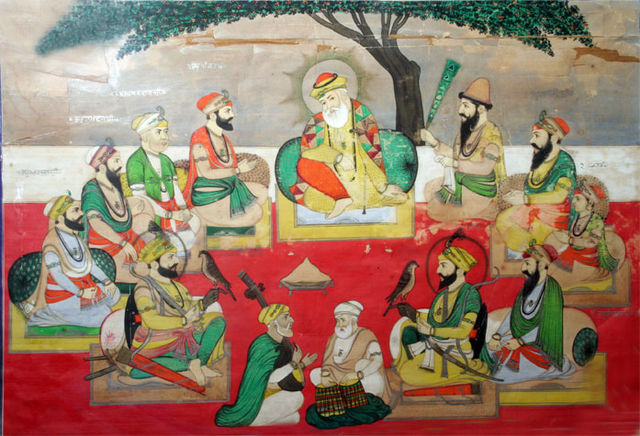Guru Tegh Bahadur was the ninth of ten gurus who founded the Sikh religion and was the leader of Sikhs from 1665 until his beheading in 1675. He was born in Amritsar, Punjab, India in 1621 and was the youngest son of Guru Hargobind, the sixth Sikh guru. Considered a principled and fearless warrior, he was a learned spiritual scholar and a poet whose 115 hymns are included in the Guru Granth Sahib, which is the main text of Sikhism.
A mid-17th-century portrait of Guru Tegh Bahadur painted by Ahsan, the royal painter of Shaista Khan, governor of Bengal, circa 1668–69
Interior view of Gurdwara Sis Ganj Sahib
Painting depicting the execution of Guru Tegh Bahadur in Chandni Chowk, Delhi.
Fresco art depicting head of Guru Tegh Bahadar being brought to Anandpur by Sikhs
The Sikh gurus are the spiritual masters of Sikhism, who established the religion over the course of about two and a half centuries, beginning in 1469. The year 1469 marks the birth of Guru Nanak, the founder of Sikhism. He was succeeded by nine other human gurus until, in 1708, the Guruship was finally passed on by the tenth guru to the holy Sikh scripture, Guru Granth Sahib, which is now considered the living Guru by the followers of the Sikh faith.
A miniature painting, dated 1890, depicting an "imaginary portrait" of the ten gurus and others.
Gurus of the Sikhs. Fresco from Dera Nirmala, Tanda-Hoshiarpur.
Imaginary Meeting of Guru Nanak and the rest of the Sikh Gurus, Bhai Mardana, and others. 1780 painting
Image: Detail of Guru Nanak from the earliest known painting of all ten Sikh gurus together, with each being identified in golden Persian nasta'liq script, probably painted in Hyderabad, circa 1780








